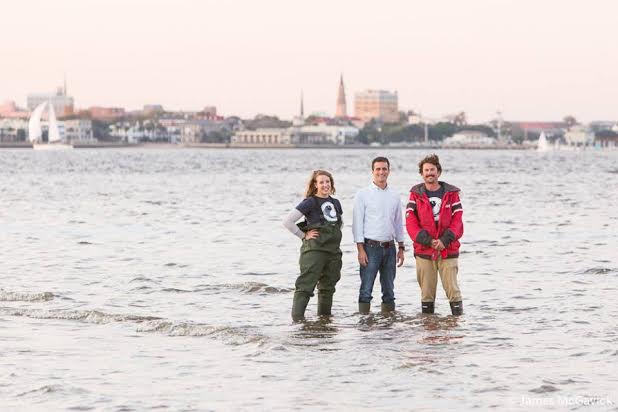
Water. It makes up around 70 percent of our body. Doctors recommend drinking at least eight glasses a day. And for folks in the Lowcountry, it acts as a source of constant entertainment. Whether taking the kayak out for a spin around Carolina tributaries or jumping in the Atlantic while visiting Sullivan’s, our waterways take on the role of refuge, friend and undeniable refresher.
One local organization is making sure the H2O stays at the quality it should in order to ensure ourselves and future generations many more days of carefree splashing and soaking. Since forming in 2008, Charleston Waterkeeper has created a ripple effect, influencing others to take action when needed. From hosting beach cleanups to doing weekly testing, they make sure our water is swimmable, drinkable and fishable.
“I’ve always been drawn to the water. Whether swimming, surfing, paddling or just mucking around in the pluff mud – it’s always just felt like where I should be and what I should be doing,” said Andrew Wunderley, who is most at home away from dry land.
While studying at the College of Charleston, Wunderley was moved by the concept that local bodies of water are there for public access, but it is up to the public to help maintain the integrity of those bodies of water. With a masters in Environmental Policy and a law degree, he brings a deep understanding and appreciation to his job as Charleston’s Waterkeeper.
“Our waterways belong to all South Carolina citizens, and we all share a responsibility to take care of them,” said Wunderley. “I’m grateful for the opportunity to be their champion and defender by serving our great community as its waterkeeper.”
While Shem Creek is one of East Cooper’s most loved bodies of water, with a bevy of restaurants overlooking it, according to Wunderley, it is in need of some TLC and healing. Over the years, the area around Shem Creek has grown at a great rate. Nearby roads, parking lots, houses and a variety of buildings direct rain and flood water into the creek, and, as a result, pesticides, oil, grease and bacteria trickle in, compromising its overall quality.
“Shem Creek is such a beautiful and iconic tidal creek with a long and rich history. It has everything that makes the Lowcountry so special – great public access, fishing, crabbing, outdoor outfitters, an active commercial fishing fleet and all manner of recreational activity from paddling to swimming,” said Wunderley. “Sadly, our water quality testing work shows Shem Creek doesn’t meet its water quality standard for safe swimming.”
Wunderley and his team are taking action to improve the quality of the water. Not only will this benefit those looking to enjoy an afternoon in the waves, but it will also help those species that reside in the water all year long. Dolphins and manatees are often a welcomed sight in Shem Creek, but action is necessary to keep them coming back. And in order for local seafood to remain fresh, tasty and safe for consumption for years to come, a strategy must be implemented.
“We’re advocating for a community-based watershed action plan designed to clean up and protect Shem Creek,” said Wunderley. “The plan will identify pollution sources and implement strategies to restore the creek’s water quality for recreational use.”
Wunderley is constantly in awe of the support he receives from neighbors determined to make a difference. Since the inception of Charleston Waterkeeper, folks have been quick to keep the nonprofit afloat by offering an extra set of hands and even donations of boats to use in the field.
“Our volunteers and supporters are a constant source of inspiration. It’s tremendously rewarding when local folks give their hard-earned time and resources to do good for our local waterways,” said Wunderley. “The capacity of our community to come together to solve problems shouldn’t ever be underestimated. It’s just great to see local folks get their hands dirty and feet wet protecting and restoring their favorite tidal creek or river.”
You can find Charleston Waterkeeper at various events throughout the Lowcountry. On July 2, for example, you can visit their booth at The Charleston Farmers Market to learn more about what you can do to keep our streams, rivers and inlets free of pollutants. Whether you’re an environmental activist or just a concerned citizen, Wunderley encourages all to dive in.
“Learn about your local tidal creek or river. Understand its history. Paddle it. Clean it up. Swim in it. Fish it. Find out where you can harvest oysters. To know your local creek is to love it. To love it is to protect it,” said Wunderley. “Get engaged. Get involved. Volunteer for a clean up. Get dirty. Help build new oyster reef. The rest will fall in place.”
When we all work for the greater good of our environment, there’s nowhere to go but upstream. To find out how you can get involved, log on to www. CharlestonWaterkeeper.com.
By Kalene McCort.

Leave a Reply